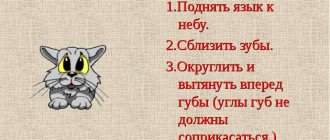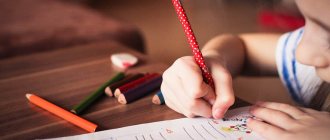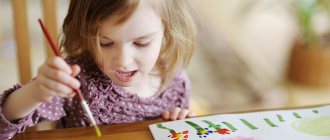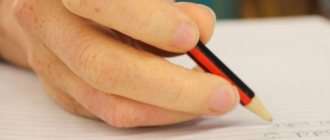Groups of sounds in speech therapy
Only a professional can deliver the correct sound to a child. The task of a speech therapist in the garden is to accustom children to standard pronunciation of letters and sounds and strengthen articulation.
Sounds in speech therapy are divided into several groups according to the place of formation:
- labiodental;
- front-lingual;
- middle language;
- posterior lingual.
Session with a speech therapist
By place of education:
- trembling;
- lateral;
- median;
- nasal;
- voiced;
- deaf.
Important! After regular lessons, the baby should pronounce all hissing and whistling sounds so that they are clearly audible and understandable. The condition for correct pronunciation is articulation.
Classification of sounds of the Russian language
The Russian language has 42 sounds, vowels and consonants.
- vowels - [a], [s], [e], [i], [u], [o];
- voiced - [v], [z], [g], [d], [g];
- sonorous - [m], [n], [l], [r];
- deaf - [s], [w], [f], [x], [sch], [h].
A child does not need to learn all sounds in kindergarten, but he must understand the mechanism of their formation and clearly pronounce both hissing and whistling sounds.
Sounds in Russian
Sound group table
A speech therapist teaches a child not just to talk, but to do so taking into account the norms of the language. Ideally, at least an average result should be achieved when the speech is delivered, but it needs to be consolidated.
Table of division of sounds into groups:
| Doubles | Unpaired | |
| Voiced | b, c, d, d, h, g | l,m,n,r |
| Deaf | p, f, k, t, s, sch | x,c,ch',sch' |
| Solid | b, c, d, e, h, j, l, m, n, p, p, s, t, f, x | w, w, c |
| Soft | b', c', d', d', h', k', l', m', n', p', p', s', t', f', x' | w', w', c' |
| Hissing | ||
| w, w, h', w' | ||
Attention! When pronouncing sounds from different groups, the position of the tongue changes. A child in kindergarten must learn to distinguish types of sounds and use articulation.
Teaching children
Federal State Educational Standard
- Federal State Educational Standard for Preschool Education
- Preparation for school
- Fear of homework
- Problems at school for children
- The task of educators in preparing children for school
- Preparing for school in kindergarten
- Preparing for school in development centers
- What's happened ?
- What should a child be able to do for school?
- Preschool education
Children
- ABC and alphabet
- Alphabet for children
- ABC by syllables
- Russian alphabet for children
- Development of fine motor skills in children
- Introducing children to books
- Alphabet from diapers
- English for children
- Early development methods
- Sensory development of children
- The Maria Montessori method is best suited for this purpose.
- Physical development of children
- Preparation for school
- Preparing for school in the summer
- Children's imagination
- Development of attention in children
- Mindfulness exercises
- Development of attention in preschool children
- Games to develop children's thinking
- Games to develop logical thinking
- Development of logical thinking in children.
- Staging sounds
- Staging sound in
- Setting the sound r
- Hissing consonant sounds - production of sounds in preschool children
- Sound setting
- How to parse a word into sounds
- Syllables for preschool children
- Letter games for children
- Let's learn letters. A game.
- Children's literacy training
- Literacy lessons
- Literacy training - Harmony program
- Teaching Zhurova literacy
- Teaching literacy - Perspective methodology
- Literacy teaching UMK School of Russia
- Reading with characters
- Learning to read with Luntik
- Fixies teach you to read
How to teach a child to say the letter B
Speech therapy in a preschool educational institution is needed so that the child can go to the junior grade at school with good pronunciation. Difficulties arise when placing different letters, including the letter [v].
Group lesson in the garden
Articulation gymnastics
In order for your baby to be able to pronounce the letter “v” normally, you need to do the following:
- the training begins with the phrase “the wind howls.” The teacher shows the child how to bite the lower lip when pronouncing in order to produce a sound;
- it is important to explain that the lower lip is only slightly bitten by the teeth during a conversation;
- if this does not work, the speech therapist lightly presses his finger on the lower lip.
Additional Information! When pronouncing the sound “v”, the articulation is the same as when pronouncing “f”, it is only important to close the vocal cords.
Exercises for sound production
Before entering kindergarten, a child must learn to pronounce words with “v.” Violations are rare, only in the presence of lip defects.
Practicing sounds with exercises
Exercises:
- Raise your upper lip several times.
- Lower your lower lip.
- Make a “fence”.
- Pull your lips inside your mouth, pressing them against your teeth.
Examples of analysis of educational activities for speech development in preschool educational institutions
After articulation exercises, the child should pronounce the words several times: “wolf”, “wind”, “rope”.
Tasks for automating the pronunciation skill [вь] and [в]
Conducting a sound lesson in the senior group, the speech therapist achieves automatic pronunciation, as a result of which sounds are differentiated. After a year, the child should go to school, where it is possible to continue working on speech, but sounds such as “v” and “f” should be worked out as early as possible.
Exercises are performed at the preschool educational institution and given at home:
- the lower lip approaches the upper teeth and exhales; you can ask the child to pretend to be a rabbit and slightly expose the upper row of teeth;
- to practice “f”, softness is added to “v”.
Additional Information! To automate the skill, the child must read words containing “v” and “f”: muskrat, exit, farm, purple, focus, wind, pinwheel.
“Automation of sound” lesson plan on correctional pedagogy (preparatory group)
Topic: sound "v".
Goal: automation of the sound “v” in coherent speech.
Tasks:
1. Correctional and educational:
- Practice the acoustically correct pronunciation of the sound “v” in coherent speech by composing a retelling.
- Update knowledge from previous lessons on the topic of the sound “v”.
2. Correctional and developmental:
- Prepare the articulatory apparatus for producing the sound “ch” through articulatory gymnastics.
- Develop fine motor skills through the “Sunshine” exercise.
- Develop the process of sound-letter analysis of words of three sounds through the “Color the Word” exercise.
- Correct auditory memory based on text retelling.
- Develop thinking by matching pictures with stories.
3. Correctional and educational:
- Develop self-control skills by focusing the child’s attention on his own pronunciation.
Dictionary: wolf, owl, halva, firewood, words, Vova, letter, razor, mane, plum, pumpkin, thief, two, willow; speech material from tests.
Materials: “Wolf” toy, mirror, story pictures, a picture of a wolf, “Sun” teaching aid, colored pencils, notebook.
Lesson duration: 30 minutes.
Progress of the lesson:
- Organizational moment (1 min).
Hello, Ilya! Sit correctly, straighten your back. To start our lesson, guess the riddle:
At night he howls in the forest:
“I’ll carry the lamb away!”
Knows a lot about hares too
Angry, hungry gray... (wolf).
A wolf cub came to visit us, but he will not offend us. He really wants to see how you do, and if you need help, he will help you out.
- Main part (28 min).
- Performing articulatory gymnastics (7 min).
Let's show the wolf cub how we can perform articulatory gymnastics. I will show you a sample of the execution, and you repeat after me, looking in the mirror. We perform each exercise with a rhythmic count (from 1 to 8, 2 times).
| Exercise | Progress |
| "Proboscis Smile" | The lips either stretch wide in a smile, or stretch forward with a proboscis |
| "Window" | Let's bare our teeth like a wolf. Raise the upper lip, lower the lower lip and pull them forward a little. |
| "Wide smile-window" | We will alternate. We bare our teeth, smiling broadly. Then we pull them out with a window. |
| "Swing" | Let's shake the tongue. Open your mouth slightly and use your tongue to alternately touch your upper and lower lips. |
| “Painting the top fence” | The lips are stretched in a smile, the mouth is slightly open. We move the tip of the tongue behind the upper teeth from side to side, as if painting. |
| "Painting the ceiling" | Now let's stroke the sky with our tongue, as if we were painting the ceiling. The mouth is slightly open, moving the tongue across the palate from front to back. |
Ilya, you are great! The wolf cub watched you closely. You did all the exercises very well.
- Exercise “Sun” and updating knowledge from previous lessons (2 min).
What sound did we study in the last lesson? (Sound "v"). The little wolf has prepared a game for you. There is an image of the sun in front of you. What is he missing? (Luchikov). The wolf cub will name the beginning of the word, and you will end this word with a syllable with the sound “v”, putting rays on the sun. One word - one ray. For example, "tra-va". Try to pronounce it clearly and beautifully.
- So-va, hal-va, wood-va, words, Vo-va, letter-va, brit-va, mane-va, plum-va, pumpkin-va.
- Work on sound-letter analysis of words (7 min.)
Ilya, do you know what colors the wolf cub likes? He has three favorite colors. Look at the pencils he brought and name the colors (red, blue, green). And we can play the game “Color the Word”. (The words are “thief”, “two”, “willow”. The work is carried out step by step with each word).
- I will tell you the word. Say it out loud.
- Write the word in your notebook.
- Color a circle under each letter; to do this, clearly name each sound in the word again. What color do we use to indicate a hard consonant, a soft consonant, or a vowel sound? (Blue, green, red).
- Work with retelling text based on images (5 min).
Ilya, there are pictures in front of you (5 pictures, but 2 stories). You will hear little stories. For each story you need to choose a picture and then tell the story in your own words. Pay attention to your pronunciation. (The teacher reads each story 2 times).
- Vova saw a film about wolves on TV. The wolf had two little wolf cubs. Then Vova saw how the wolves taught the cubs to hunt. From the film, Vova learned a lot about the habits of wolves.
- Varya and Klava are friends. One day they bought Varya a new doll. She went out for a walk with a new doll, but Klava was still not there. Varya went to the window and shouted: “Klava, come out.” They bought me a new doll! Klava’s mother looked out the window. - Klava is sick. Play alone,” she said. Varya almost cried, and then said: “Here, give Klava my new doll.” May he recover quickly.
- Work with text retelling (7 minutes).
Ilya, now you will hear a story from the life of our guest. Your task is to listen carefully, answer the questions, and then tell it in as much detail as possible. Pay attention to your pronunciation.
One day Vova and Vanya went into the forest. They took a bucket, some water and a couple of cheesecakes. They collected cranberries in the forest. Grandma Valya promised to make jam from it. Suddenly, Vova and Vanya heard someone howling pitifully in the bushes. They got scared and began to wait. Suddenly a wolf cub came out of the bushes. He began to slowly hobble towards Vova and Vanya. It turned out that the wolf cub had a dislocated leg; he probably fell into a hunter's trap. The boys gave him some water. Vova ran home to call for help, and Vanya looked after the wolf cub. Soon the wolf cub was saved. He was happy and did not want to return to the forest at all.
Questions to the text (must be answered in full):
- What were the boys' names?
- What was their grandmother's name?
- Where are the boys going?
- What did they take with them?
- What did the boys hear?
- Who did the boys see next?
- What did they do with the wolf cub?
- How did the wolf cub behave after recovery?
- Final part (1 min).
Ilya, who came to visit us today? (Little Wolf). What sound did we remember today? (Sound "v"). You tried very hard and did a lot of exercises. The little wolf wants to give you a postcard with his photo as a souvenir and wish you success!
Speech therapy session: hear and pronounce the sound [n] correctly
Speech therapy classes in the garden sound p are carried out according to the following program:
- Organizational moment, the beginning of the lesson. Children enter the office, the speech therapist asks 5-6 riddles, after which he announces the topic of the lesson.
- The teacher reads a poem to develop speech hearing.
- Articulation of the sound "p". The speech therapist asks the children whether “p” is a vowel or a consonant, shows them how to pronounce it and asks them to repeat after themselves, noting the children who do not succeed. Individual work will be carried out with them.
- Exercise “Attentive Ears”. The teacher reads the text and asks them to clap when the children hear the letter “p”.
- Work in a notebook - writing letters, selecting words.
- Zaitsev's cubes. Children find the syllables PA, PO, PU and pronounce them.
Cubes for speech therapy
At the end of the lesson, children are given homework - to find words and sentences with the letter “p”, write them down and learn to pronounce them.
How to teach a child to say the letter K
Parents often ask a speech therapist how to teach their child to pronounce the letter k. There is only one answer - the most effective method is constant pronunciation.
The simplest task is to regularly pronounce words with the letter “k”: cabbage, strawberry, potato, card, book, dill, spark.
At the same time, it is important to focus the child’s attention on this letter and pronounce it clearly and slowly. Children most often achieve the main progress in pronunciation in classes at preschool educational institutions.
Speech therapy lesson on differentiation of sounds [g] and [k]
How to teach a child to say the letter k if he refuses to do speech therapy? Home training often does not bring the expected result, but in kindergarten the speech therapist uses a playful approach and engages the child in play. A ready-made outline is used for the lesson.
Lesson progress on differentiating “g” and “k”:
- The teacher asks the child to guess riddles, the answers to which contain the sounds being practiced. Then he announces the topic of the lesson and the purpose.
- Kids are asked the question: “What is the difference between “g” and “k”? Children should say that they have different sounds, teeth and tongue positions when pronouncing. The speech therapist invites children to pronounce words with their hand on their throat. The sound is very different.
- Work is underway with notebooks. The guys write down the syllables: gu-ku, gi-ki, go-ko, ga-ka and pronounce them. A fast pace and its alternation with a slow one is important.
- At the end of the lesson, the children pronounce pure sayings: “ha-ha-ha - the geese came out into the meadows.”
How to teach a child to speak the sound [r] without a speech therapist at home
After the main block of the lesson, children do a warm-up and then do an exercise in which they need to insert the missing letters in a word.
Important! During the lesson, the speech therapist pays attention to the children for whom pronunciation is most difficult, and then conducts individual work with them.









